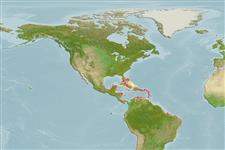Demospongiae |
Chondrillida |
Chondrillidae
Environment: milieu / climate zone / Mức độ sâu / distribution range
Sinh thái học
; Thuộc về nước lợ; Mức độ sâu 1 - 2 m (Tài liệu tham khảo 86836). Tropical
Western Central Atlantic: Caribbean.
Length at first maturity / Bộ gần gũi / Weight / Age
Chín muồi sinh dục: Lm ? range ? - ? cm
Chondrilla caribensis f. hermatypica: shiny mustard to greenish yellow; tough encrustations. Chondrilla caribensis f. caribensis: grayish to reddish brown; thickly encrusting; often lobed (Ref. 82089). Grows in any combination of thick encrusting lumps, pillows, low mounds, sheets, or runners. Surface is shiny, smooth and slippery. External color: combination of yellow brown and greenish to dark brown, sides often paler; cryptic specimens completely pale white or tan. Internal color: cream. Tough consistency. Oscules scattered or on top of pillows or mounds; usually small, flush or indented with a collar that may be elevated or indented (Ref. 85482).
Depth range from Belize and Panama (Ref. 86836). Occurs in shallow hard bottoms. Often attaches to seagrass blades, dead finger coral branches, mangrove prop roots and artificial structures (Ref. 85482).
Life cycle and mating behavior
Chín muồi sinh dục | Sự tái sinh sản | Đẻ trứng | Eggs | Sự sinh sản | Larvae
Members of the class Demospongiae are hermaphroditic. Life cycle: The zygote develops into parenchymella larva (free-swimming) before settling down on a substrate where it grows into a young sponge.
Rützler, K., S. Duran and C. Piantoni 2007 Adaptation of reef and mangrove sponges to stress: evidence for ecological speciation exemplified by Chondrilla caribensis new species (Demospongiae, Chondrosida). Mar. Ecol. 28 (Suppl. 1):95-111. (Tài liệu tham khảo 82089)
IUCN Red List Status
(Tài liệu tham khảo 130435: Version 2025-1)
CITES status (Tài liệu tham khảo 108899)
Not Evaluated
CMS (Tài liệu tham khảo 116361)
Not Evaluated
Threat to humans
Harmless
Human uses
| FishSource |
Các công cụ
Thêm thông tin
Sinh thái dinh dưỡngFood items (preys)
Thành phần thức ăn
Thành phần thức ăn
Các động vật ăn mồi
Population dynamicsSự sinh trưởng
Max. ages / sizes
Length-weight rel.
Length-length rel.
Length-frequencies
Mass conversion
Sự phong phú
Life cycleSự tái sinh sảnChín muồi sinh dụcSự sinh sảnĐẻ trứngEggsEgg developmentLarvae PhysiologyThành phần ô-xy
Human RelatedStamps, coins, misc.
Các nguồn internet
Estimates based on models
Preferred temperature
(Ref.
115969): 25.5 - 28.2, mean 27.2 (based on 367 cells).
